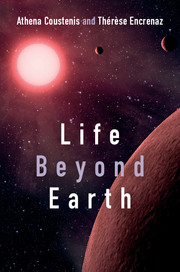Book contents
- Frontmatter
- Contents
- Preface
- 1 Introduction
- 2 What is life and where can it exist?
- 3 Terrestrial planets and their diverging evolutions
- 4 Searching for habitable sites in the outer Solar System
- 5 A revolution in astronomy: the exploration of extrasolar planets
- 6 Extraterrestrial habitable sites in the future
- Further reading
- Index
- Plate Section
5 - A revolution in astronomy: the exploration of extrasolar planets
Published online by Cambridge University Press: 05 October 2013
- Frontmatter
- Contents
- Preface
- 1 Introduction
- 2 What is life and where can it exist?
- 3 Terrestrial planets and their diverging evolutions
- 4 Searching for habitable sites in the outer Solar System
- 5 A revolution in astronomy: the exploration of extrasolar planets
- 6 Extraterrestrial habitable sites in the future
- Further reading
- Index
- Plate Section
Summary
From dream to reality
Are there inhabited worlds elsewhere in the Universe? The question is as old as humanity. We can trace such debates back to antiquity, in texts written by Greek philosophers such as Epicurus (341–270 BCE) in particular. At the time of the Copernican revolution, a new dimension was reached, this time more on astronomical and physical grounds: since the Earth was no longer seen as the centre of the Universe, other planetary systems could exist around other stars. Giordano Bruno (1548–1600) was among the first to express his support for this new astronomical theory, in opposition to the Catholic church, a conviction for which he paid with his life. Many scientists such as Galileo (1564–1642) and Huygens (1629–1695) supported this hypothesis. Closer to our times, philosophers such as Fontenelle (1657–1757) and Kant (1724–1804), scientists such as Laplace (1749–1827) and later Flammarion (1842–1925) raised the question of the plurality of worlds.
The search for planets around other stars – also called ‘extrasolar planets’ or ‘exoplanets’ – did not start in earnest, however, until the twentieth century, because of our inability to observe them. Indeed, it is extremely difficult to detect the intrinsic visible light of such a planet, hidden in the blinding brightness of its host star, which is about ten million times brighter. Imaging extrasolar planets directly, in a few very favourable cases, has only become possible during the past decade, thanks to the development of techniques such as coronagraphy (which blocks light from the centre of a telescope in order to image the fainter surroundings) and adaptive optics (see Subsection 2.4.3). During the twentieth century, indirect methods had to be developed. The idea is the following: the light of the exoplanet is too weak to be detectable, but the presence of the planet induces a small motion of the host star around the centre of gravity of the combined star–planet system. The first method used by astronomers to detect this motion was astrometry, the measurement of stellar positions relative to their background. It was successfully applied by Bessel (1784–1846) who first detected a low-mass companion around Sirius A, the brightest star in our skies. The companion turned out to be a white dwarf, named Sirius B. A century later, the same technique was used to search for exoplanets.
- Type
- Chapter
- Information
- Life beyond EarthThe Search for Habitable Worlds in the Universe, pp. 187 - 234Publisher: Cambridge University PressPrint publication year: 2013

